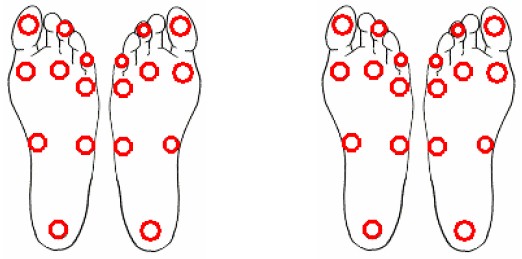|
Diabetic Neuropathy is a degenerative disease of the peripheral nerves and a common complication of diabetes. Autonomic, sensory and motor functions may be affected individually or in combination with varying degrees of severity. This nerve damage can create conditions in the foot that produce secondary problems such as deformity and foot ulceration, which may lead to amputation. It is our hope to minimize or eliminate the devastating effects of peripheral neuropathy through careful monitoring of the feet using a foot screen, patient education and appropriate referral to a foot care specialist when needed.
Three levels of screening exist for the diabetic foot depending on the level of expertise of the individual performing the evaluation.
The Level Three Leap Foot Screen requires advanced knowledge of foot biomechanics and is usually performed by a physician or physical therapist. It is designed to evaluate Range of Motion/Strength, Sensation, Skin Condition, Nerve Status, Vision, Mobility, Deformity and Vascular Status resulting in patient placement into a Risk Category that dictates the follow-up and treatment regime.
Foot Evaluation
Date ___/___/______
Name __________________________ ID # ___________
History
DM Type I or Type II on Insulin , Oral Agents , None
Other Dx: _____________________________________________
HX Foot Ulcer Y_ N_, Surgery Y_ N_
Employed Y_ N_, or Homemaker Y_ N_, Student Y_ N_
Activity Sitting ___% vs Standing/Walking ___%
Indep Amb__ , W/AmbAids__ , SBA__ , Assist__ , WC__
Ambulation Distance: Unlimited__ , Limited Community__ ,
Homebound__ , Non-ambulatory__
Exercise Y_ N_; H-Impact , L-Impact__ , # __ days/wk
Other __________________________________________________
ROM/Strength
| Rt. ROM |
Rt. MMT |
|
Lt. MMT |
Lt.ROM |
| |
|
Ankle Dorsiflexion |
|
|
| |
|
Ankle Plantarflexion |
|
|
| |
|
Ankle Inversion |
|
|
| |
|
Ankle Eversion |
|
|
| |
|
Great Toe Extension |
|
|
| |
|
Great Toe Flexion |
|
|
| |
|
Intrinsics (graded 0-2) |
|
|
Sensation/Skin
Sensory Level: 1 = 1gm, 2 = 10gm, 3 = 75gm, 4 = > 75gm
| LEFT |
 |
RIGHT |
Label: D = dryness, S = swelling, R = redness, T = temperature
M = maceration, C = callus P = pre-ulcer U = ulcer
Vascular
| Right |
|
Left |
| Y_ N_ |
Dorsal Pedal Pulse |
Y_ N_ |
| Y_ N_ |
Posterior Tibial Pulse |
Y_ N_ |
| Y_ N_ |
Shiny, hairless, atrophic skin |
Y_ N_ |
| Y_ N_ |
Capillary refill < 3 sec |
Y_ N_ |
Other _____________________________________
Deformities
| Right |
|
Left |
| |
Hammer / Claw Toes |
|
| |
Bunion / Bony Prominence |
|
| |
Planus / Cavus |
|
| |
Hallux Limitus |
|
| |
Rear/Forefoot Varus |
|
| |
PF 1st Ray/Forefoot Valgus |
|
| |
Dorsiflexed First Ray |
|
| |
Equinus /Calcaneus |
|
| |
Drop Foot |
|
| |
Charcot Fracture |
|
| |
Partial Foot Amputation |
|
Mobility/Vision
| Right |
|
Left |
| Y_ N_ |
Able to Identify a Foot Mark |
Y_ N_ |
Footwear
Standard Y_ N_
Prescription Y_ N_
Describe: __________________________
Appropriate Y_ N_
Worn Y_ N_
Assessment
1. Foot Injury Risk
__0 - No loss of protective sensation
__1 - Loss of protective sensation
__2 - Loss of protective sensation and high pressure (callus or deformity) and/or poor circulation
__3 – History or foot ulcer or Charcot fracture
2. _______________________________________
3. _______________________________________
Plan /Goals
Instruct in self care/ Independent foot inspection footwear selection appropriate foot care __
Fit and train in Crutches Walker__ / Independent NWB PWB gait __
Evaluate Orthotic Footwear Prosthesis__ / Proper fit and prevent tissue injury __
Instruct in Exercises / increase ROM increase Strength__ general conditioning __
Fabricate foot orthoses shoe modification__ / Prevent tissue injury __
Fabricate a Relief Pad Healing shoe Contact Cast Walking Splint __/ Off-load pressure __
Debride wound__ / clean wound and promote healing __
Other ________________________________________
Frequency/Duration _____________________________
Signature _____________________________________
Screening for loss of protective sensation (LOPS) is the key step in the LEAP Program.
Using the 5.07/10 gram monofilament, the clinician tests 4 plantar sites on each foot (8 sites total) and indicates a positive or negative response for each site tested. A negative response at any site identifies LOPS and considers this patient at high risk for plantar ulceration.
If the patient has a LOPS but no history of plantar ulceration, follw up and re-evaluation of the foot should accur at least twice a year. In addition, protective footwear must be worn at all times and the patient is discouraged from going barefoot. A soft custom insole is recommended for all of the patient's footwear and shower sandals are encouraged.
The vulnerability of the foot when protective sensation is absent should not be taken lightly and education of the patient on the risks of ulceration should be stressed.
|